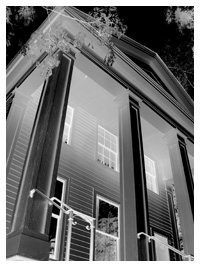
A Message from Beyond
Dr. Hamilton Daniels was a beloved physician and druggist in Naperville during the second half of the nineteenth century. While he had a shop downtown, his home was on Washington Street near the DuPage River. The house has since been moved onto the grounds of Naper Settlement.
Dr. Daniels was a widower who married a widow, Caroline Hough. Between them, they raised half a dozen children. He is buried in the city cemetery.
In this story, Caroline Howard visits the Daniels family. She and her daughter held many a seance at their home in St. Charles. Still standing, it is privately owned, lovingly cared for and seasonally decorated. It's hard to picture it as the old home of a famous spiritualist!
A story about Mary Todd Lincoln visiting Caroline Howard after the deaths of her son and husband is local legend. Spiritualism was extremely popular during the 1800's. While there is no record of Mrs. Howard holding a seance at the Daniels House, she was a local celebrity and they were a wealthy and popular family. It is entirely possible that they were acquainted.
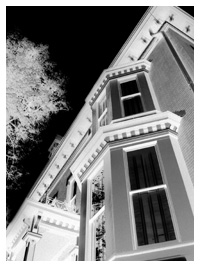
Caretakers of the Mansion
When George Martin I moved from Scotland to Naperville, Illinois, he built a log home for his family on the site of the present day Rotary Hill, near where the Millennium Carillon sits.
Soon George Martin I upgraded to a frame house, but it was son George Martin II who really improved the family fortunes. His stone quarries and brick making business helped rebuild Chicago after the Great Fire in 1871.
By 1883, George Martin II moved his family across the street, out of the old frame house and into a splendid brick mansion that they called Pine Craig.
One by one, the Martin family passed on until only daughter Caroline Martin Mitchell was left in the home. Caroline bequeathed the house and the surrounding estate to the city of Naperville after her death and the home became the Historical Society's first musum.
Now known as the Martin-Mitchell Museum, it is the crown jewel on the grounds of the Naper Settlement living history museum.
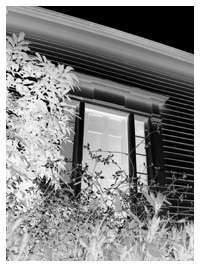
The Nightly Nursemaid
When Naperville was founded in 1831 by Joseph Naper, his nephew Robert Murray was a seventeen-year-old boy and one of the original settlers. The story of the journey from Ohio to Illinois on Uncle Joe's schooner is told from the point of view of Robert's sister, Ruth, in the book Ruth by Lake and Prairie, also by Katharine Kendzy Gingold.
Robert Murray grew up to become a sheriff, innkeeper, lawyer, judge, and one of the first mayors of Kankakee, Illinois. Murray's interest in politics introduced him to Stephen Douglas and they became close friends, with Murray accompanying him on at least one campaign trail.
While we have no record of Sophia Staga serving as a nursemaid in the Murray household, she did live in the area. And died there, as well. Sophia's name appears in the Mortality Schedule that is partially reproduced in the story "Death,the Frequent Visitor."
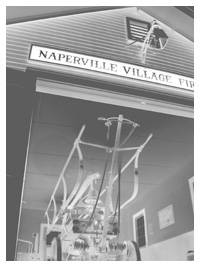
The Phantom Fire Brigade
Following the Great Chicago Fire of 1871, fire safety became a "hot" issue for many cities. In response, Naperville created their first fire department in 1874.
The Joe Naper pumper was a hand-drawn, hand-pumped wagon that brought water and hoses to the site of a fire. The pumper is still occasionally demonstrated during the summer months at the Naper Settlement living history museum.
For an even more in depth look at firefighting history, the Aurora Regional Fire Museum is just a few miles outside of Naperville and boasts an impressive collection of artifacts, photographs, and other historical items.
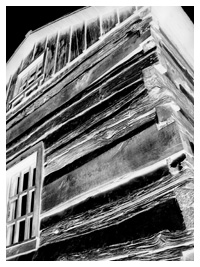
Death, the Frequent Visitor
Most of Illinois' early settlers built log houses rather than log cabins. They were always meant to be temporary dwellings until the family could afford, and the settlement's technology could provide, the means to build an eastern-style frame house.
Some log houses were incorporated into these later homes. Some were used as sheds or barns. Many eventually fell into disrepair and rotted into the soil.
When interest in preserving local history became popular, it was often too late for communities to save the log houses of their original settlers. Towns built reproductions or shipped in authentic log homes from other areas.
These transplanted homes represent the history of their new communities, but of course they already have a history of their own, one that is now forgotten by all but the ghosts who still dwell there.
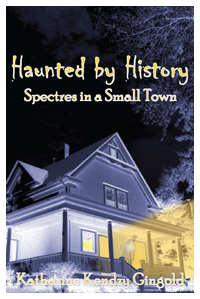
About the Cover
Kate and Don spent a great deal of time looking for a house that would be the quintessential small town home with enough of a historical look to appear to have a history.
After all, the point of the book is to learn a little more about the history of a place, and do so in a fun way. Ghost stories are fun! It stands to reason that a ghost story based on real people who once inhabited a home would be both fun and educational.
Since the sub-title spoke of small towns, they chose a building that typified small town America - not too ornate, definitely not modern. They looked at several homes in western Chicagoland and finally settled on this house. It's not a home described by any of the stories in the book, and to the best of their knowledge, it does not have historical significance, but it visually gets the point across.